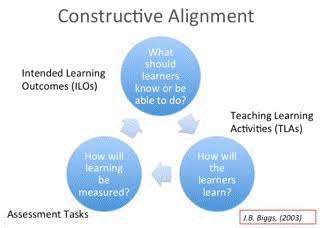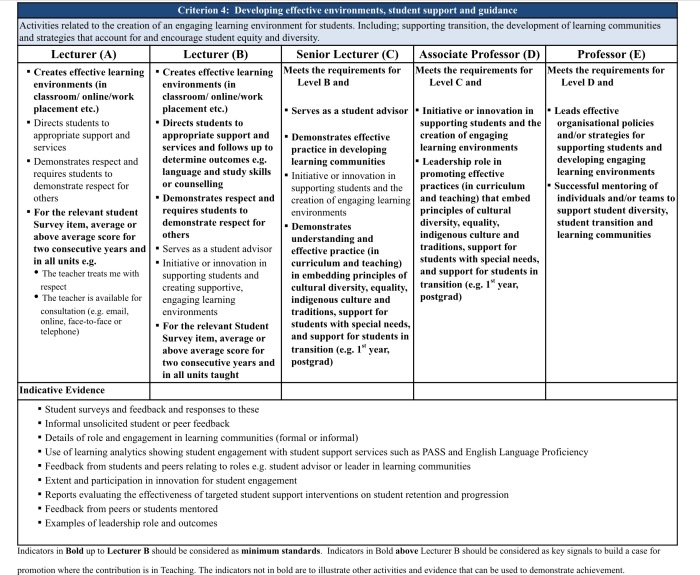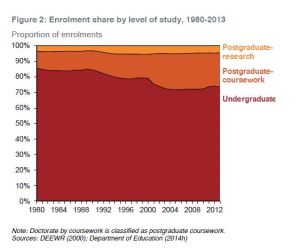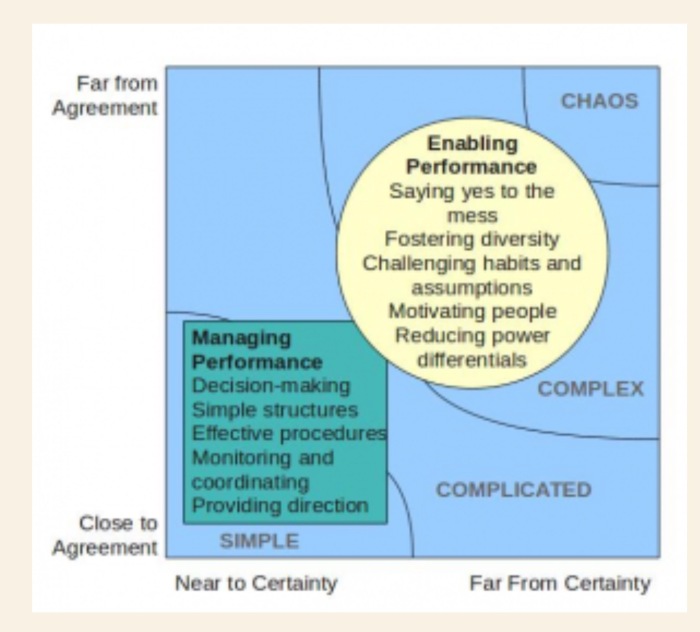.
Click to access Guidelines-conjoint-appointment-promotion.pdf
First, some definitions……
Before we move onto that, though, I wanted to get some definitions straight in my head…and i have rather inexpertly tried to capture it diagrammatically.

What is Tertiary Education?
Wikipedia (2017a) defines Tertiary Education as education which follows secondary (high school) education and includes higher education and further or continuing education.
What is Higher Education?
Higher education, as defined by Wikipedia (2017b) is tertiary education resulting in awarding of degrees (as opposed to further or continuing education results in non-degree qualifications. HE institutions include: universities, academies, colleges, seminaries, conservatories and institutes of technology, and some vocational and trade schools. An academic is someone who works as a teacher or researcher at a HE institution and who usually holds a higher degree (2017c).
What is a University?
The definition of a “university” as provided by Wikipedia (2017d) emphasises the key features of universities as an institution of undergraduate and postgraduate education and research consisting of a community of teachers and scholars which awards degrees.
What is Vocational Education?
Wikipedia (2017e) defines Vocational Education )sometimes known as career education ) as education “which prepares people to work in a trade, a craft, as a technician or in professional vocations such as engineering, accounting, nursing, medicine, architecture or law.” It can occur in all the tertiary settings as outlines, and also as part of secondary education.
What about medical education?
In Australasia, basic training of medical practitioners is vocational training which occurs at universities (either undergraduate or post-graduate, where students must already hold minimum of a bachelor degree), “Pre-vocational training” occurs during the first two years after graduation from the basic medical training and occurs under the auspices of each state’s postgraduate medical councils Australian Medical Council (AMC), guided by the Prevocational Medical Accreditation Framework and the Australian Curriculum Framework for Junior Doctors.
Post-graduate training of medical specialists and Continuing Medical Education (CME), which occur after completion of specialist training are delivered by Medical Colleges.
Medical Colleges
Wikipedia (2017f) defines medical colleges as “trade associations” which brings together practitioners in geographical and / or medical specialities. In Australasia, the medical colleges are Higher Education institutions delivering Wikipedia (2017f) defines medical colleges as “trade associations” which brings together practitioners in geographical and / or medical specialities.Vocational Education to postgraduate medical practitioners.
For example, the roles of the Royal Australasian College of Physicians (RACP) (RACP, 2016) include:
- Provide accredited specialist training, which results in awarding of fellowship from the college (including divisions, faculties and chapters), which designates that the individual is a specialist in that particular field, as recognised by the AMC and the Australian Health Practitioner Regulation Agency (AHPRA) which allow the doctor to bill under Medicare.
- Provide accredited continuing professional development / education following completion of training
- Advocacy for healthcare policies which promote the interests of the profession, patients and the community
- Support trainees / fellows in research through providing fellowships, grants and prizes.
….and so, on with the topic de jour, or semaine as the case may be
Identify and analyse trends in staff development and building careers in your context. What impact does this have on staff in your work place?
Teaching is part of the core business of HE institutions and documentation of qualtiy in this areas is receiving increasing focus, seeing the development of professional standards frameworks. But how can these be applied? And are they relevant in all populations of teachers in HE?
Mix and Match
As mentioned in the definitional exploration above, the key roles of universities are research and teaching. Institutions vary greatly with respect to:
- Relative prioritisation of teaching and research
- Relative funding for teaching and research
- Given ratio of teaching, research and service commitments within an academic’s workload, which may be standardised across the institution
- Employment of academics with relatively heavier teaching or research emphasis
- Relative priority given to teaching and research within different faculties and schools within one university, contributing to the net focus for the particular institution
Increasing focus on quality of teaching
- institutions compete for students and funding based on league tables which have traditionally been biased towards research outputs, particularly for those generated by various newspapers, such as the Times and the Guardian. The reason for this focus has an historical basis, and relates primarily to the relative ease of obtaining this information (counting article outputs) and the complexity of rating teaching.
- There is an increasing focus on including measures related to teaching at universities. For example, the Complete University Guide. Even in this table, direct measure of teaching quality and professional standards for teaching are not included, only indirect effects of this essential element of universities. In ranking institutions, this service includes weighted considerations of:
- Entry standards,
- student satisfaction,
- research quality and intensity,
- graduate prospects, staff:student ratio,
- spending on academic services and facilities,
- honours, and
- degree completion.
Professional standards frameworks – constructive alignment for teachers
There has been rapid evolution of professional standards in higher education which may address one or more of: research, teaching and service. Parallels can be drawn between the roles of a professional standards framework for teaching and constructive alignment for learning. If professional standards are the equivalent of intended learning outcomes in Biggs’ constructive alignment, then it must be matched with the equivalent of Teaching and learning activities through a professional development program, and furthermore, married up with a means of assessment.

Utility of professional standards – why bother?
- With the expansion of HE institutions, ensuring that a minimum standard of education is met – which has inherent advantages for the industry, as well as for parties with a vested interest in the industry, investors, governments, future employers and for reassurance of the general population
- Benchmarking – individual institutions are compared with others with the purpose of maintaining current strengths and improving domains where institutions are failing
- Evaluating and improving overall quality of teaching in HE (Is there any evidence for this?)
- Evaluating and improving individual teaching quality
- Evaluation as research where evaluation of practice feeds into enhancement and im
- Improve educational outcomes for students (Is there any evidence for this?)
- Assist potential students with self-selection of institutions at which they will study (via League tables)
Professional standards frameworks
Professional standards are embedded within frameworks which include professional development activities and means of evaluating the standards, feeding into formal recognition internally and externally (promotions) through a process paralleling constructive alignment as previously explored. Examples of professional development frameworks (plus see images below):
1. The United Kingdom Professional Standards Framework (UKPDF): this has been adopted by the Higher Education Academy), which is “), a nationally-recognised framework for benchmarking success within HE teaching and learning support” (HEA, 2015). This framework’s dimensions are: knowledge, areas of activity and values (HEA, 2011), and level of performance in these areas as outlined in a “matrix” correlates with HEA related “levels” such as associate fellow, principle fellow, and inter-relates with the accreditation of universities nationally.

2. Framework for evaluating teaching in U21 institutions: The draft framework was released in 2016 by the Education Innovation Steering Group, Universitas 21 as “a common framework that could be used to guide practice across the network for evaluating teaching as part of academic promotion processes” (Universitas 21, 2017), which had been evaluated as being valid, fair and fit for purpose (EISG, 2016). In the dimension of teaching (practice), it articulates three forms of expression / practice (practitioner – do, leader – develop and manager – evaluate) across four dimensions of teaching (learning facilitator, educational designer, reflective teacher, and scholarly teacher) (see below).

* Universitas 21 was founded in 1997 and currently consists of 26 member institutions including UNSW and is “the leading global network of research universities for the 21st century” (Universitas 21, 2017) and was established as “international reference point and resource for strategic thinking on issues of global significance” (Wikipedia, 2017g).
3. UNSW: The Academic Capabilities development Framework is the framework proposed by Marshall, Poole-Warren and Buttery (2016) for use at UNSW, and which is relevant both for paid academic and non-academic staff. For all staff, there is the “academic and staff development framework”, with three dimensions (level of depth of enquiry, capabilities and career stage) (top right two pictures) and correlating with a development program (top left picture). For academic staff (research and teaching), there is the academic capabilities development framework, consisting of practice, leadership and management aspects (as described in the U21 framework above) (fourth image) – all screenshots from Fox (2017).
Furthermore, “Educational Excellence: the UNSW Scientia Educational Experience” is identified as a part of the “Academic Excellence” priority area in the UNSW 2025 Strategy (UNSW, 2015), and as part of this, the development of “Education Focussed Careers”, being supported by substantial investment of resources. Presumably, these above frameworks will play a key role in eliminating progression under this new paradigm.
Here, peer evaluation of teaching will be one element informing promotion pathways in teaching focussed careers (UNSW, 2017c). This subject will be further explored in Assessment two for this subject, particularly as it relates to promotion pathways for conjoint educators.
3. University of Notre Dame: this is another institution at which I have responsibilities. I was surprised to see it is using yet another framework: the: Australian University Teaching and Criteria and Standards, which consists of seven teaching standards (see below) which can be used to define quality teaching for universities and individual educators. It is based on the UKPSF, the literature and which has been trialled and validated. This was developed in Western Australia, and by extension, UND Sydney also uses it.


4. The RACP, being both an educational institutions nd professional body is introducing a “Professional Practice Framework” (RACP, 2016) (see below), one element of which will be teaching and learning. 

For each “domain”, standards will be define for different points throughout the physician hourney: from basic training, to advanced training and practice as a physician.

Available information about the teaching and learning domain is limited. Currently, there appears to be little description of the role of supervisors / teachers / educators / mentors in the education process.
What about unpaid conjoints and casual staff?
While engagement with frameworks such as those outlined above could be assured where national accreditation ans career progression is dependent on a framework, using frameworks to motivate and drive improved teaching is less clearcut where an educator lacks investment in a particular institution, being a casual staff member, or where teaching services are provided voluntarily as in the conjoint medical workforce. For casual staff, investment of time and money in attending professional development programs and documenting evidence would both not be in the institution’s budget, nor would most staff be willing to invest their own resources there, and for medical conjoint staff, if requirements become too onerous, there may be a complete disengagement with the education process (as is anecdotally happening in some public hospital settings [personal correspondence, name withheld for confidentiality purposes, May 2017). The existing conjoint promotions pathway at UNSW, for example (UNSW, 2010)) is rather indistinct and poorly defined. I have personally heard disquiet about appointment of certain conjoint senior positions, stating I that “they had done their time and deserved the A/Prof status, despite limited involvement in educaiton at UNSW. The university is stuck in a difficult position: either increase and tighten standards, risking disengagement with a thrifty teaching staff, or potentially deny medical students of optimal educational quality.
In conclusion
Professional standards in teaching is receiving increasing attention as the HE industry shifts. Professional standards frameworks go some way to improving quality of teaching, but there are issues related to use of a wide variety of standards across institutions, and challenges in applying these standards in particular populations of educators.
Hopefully this renewed focus on quality of teaching will improve outcomes for students, which is really what education is all about. And further, that this direction will address the issues captured in Bob Fox’s quote from this week’s session: “There are not many professions where you don’t need a professional qualification to practice other than teaching in HE.”
References
- Education Innovation Steering Group (EISG), Universitas 21. (2016). A conceptual Framework for Teaching in U21 Institutions: The Framework Validation Project. Retrieved 2017_06_06 from http://www.universitas21.com/RelatedFile/Download/818
- HEA. (2011). The UK Professional Standards Framework for teaching and supporting learning in higher education 2011. Retrieved 2017_06_07 from https://www.heacademy.ac.uk/system/files/downloads/uk_professional_standards_framework.pdf.
- HEA. (2015). UK Professional Standards Framework (UKPSF). Retrieved 2017_07_06 from: https://www.heacademy.ac.uk/ukpsf.
- Marshall, B., Poole-Warren, L., & Buttery, N. (2015). Academic and Staff Development: A model for a new context. UNSW.
- RACP. (2016a). About the RACP. Retrieved 2017_06_06 from: https://www.racp.edu.au/about/about-the-racp.
- RACP. (2016b). Professional Practice Framework. Retrieved 2017_06_09 from:
- The Complete University Guide. (2017). Methodology. Retrieved 2017_06_06 from https://www.thecompleteuniversityguide.co.uk/league-tables/methodology/.
- Universitas 21. (2017). Teaching Indicators and Framework Project. Retrieved 2017_07_06 from: https://www.racp.edu.au/trainees/curricula/curricula-renewal/professional-practice-framework, http://www.universitas21.com/article/educational/details/309/teaching-indicators-and-framework-project.
- UNSW. (2010). Guidelines for Conjoint Staff: Appointment and Promotion Levels. Retrieved 2017_06_09 from: https://med.unsw.edu.au/sites/default/files/_local_upload/others/Guidelines-conjoint-appointment-promotion.pdf.
- UNSW. (2015). UNSW 2025 Strategy. Retrieved 2017_06_09 from: https://www.2025.unsw.edu.au/sites/default/files/uploads/unsw_2025strategy_201015.pdf.
- UNSW. (2017a). Academic Performance Expectations. Retrieved 07_06_2017 from: https://www.hr.unsw.edu.au/employee/acad/Academic_Expectations_Framework_2017.pdf
- UNSW. (2017b). Education Focussed Careers. Retrieved 2017_06_09 from: https://teaching.unsw.edu.au/education-careers.
- UNSW. (2017c). Peer Evaluation of Teachijng. Retrieved 2017_06)( from:https://teaching.unsw.edu.au/peerreview.
- Vigentini, G. (2016). EDST5124 Class 5 slides: Steering change in the right direction: evaluating, monitoring and sustaining change. UNSW Moodle retrieved 2017_07_06 from: https://moodle.telt.unsw.edu.au/pluginfile.php/2167894/mod_resource/content/0/EDST5124_2016_Class5_v1.pdf.
- Wikipedia. (2017a). Tertiary Education. Retrieved 2017_06_06 from: https://en.wikipedia.org/wiki/Tertiary_education.
- Wikipedia. (2017b). Higher Education. Retrieved 2017_06_06 from: https://en.wikipedia.org/wiki/Higher_education
- Wikipedia. (2017c). Academy (Educational Institution). Retrieved 2017_06_06 from https://en.wikipedia.org/wiki/Academy_(educational_institution)#Academic_personnel
- Wikipedia. (2017d). University. Retrieved 2017_06_06 from https://en.wikipedia.org/wiki/University.
- Wikipedia. (2017e). Vocational Education. Retrieved 2017_06_06 from https://en.wikipedia.org/wiki/Vocational_education
- Wikipedia. (2017f). Medial College. Retrieved 2017_06_06 from: https://en.wikipedia.org/wiki/Medical_college.
- Wikipedia. (2017g). Universitas 21. Retrieved 2017_06_7 from: https://en.m.wikipedia.org/wiki/Universitas_21.






















 trusty
trusty 















